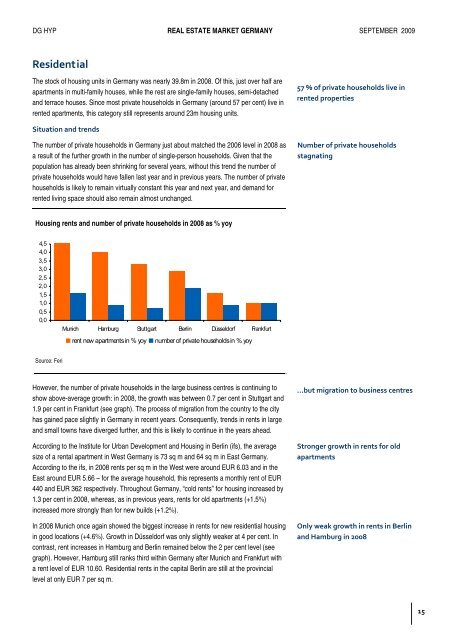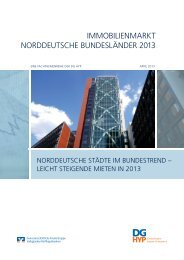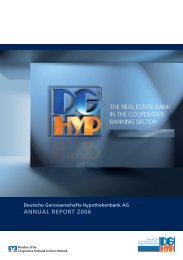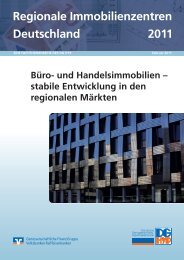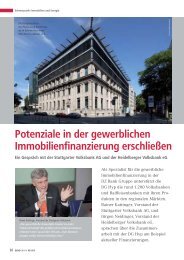Real Estate Market Germany 2009 - Deutsche Genossenschafts ...
Real Estate Market Germany 2009 - Deutsche Genossenschafts ...
Real Estate Market Germany 2009 - Deutsche Genossenschafts ...
Create successful ePaper yourself
Turn your PDF publications into a flip-book with our unique Google optimized e-Paper software.
DG HYP REAL ESTATE MARKET GERMANY SEPTEMBER <strong>2009</strong><br />
Residential<br />
The stock of housing units in <strong>Germany</strong> was nearly 39.8m in 2008. Of this, just over half are<br />
apartments in multi-family houses, while the rest are single-family houses, semi-detached<br />
and terrace houses. Since most private households in <strong>Germany</strong> (around 57 per cent) live in<br />
rented apartments, this category still represents around 23m housing units.<br />
Situation and trends<br />
The number of private households in <strong>Germany</strong> just about matched the 2006 level in 2008 as<br />
a result of the further growth in the number of single-person households. Given that the<br />
population has already been shrinking for several years, without this trend the number of<br />
private households would have fallen last year and in previous years. The number of private<br />
households is likely to remain virtually constant this year and next year, and demand for<br />
rented living space should also remain almost unchanged.<br />
Housing rents and number of private households in 2008 as % yoy<br />
4,5<br />
4,0<br />
3,5<br />
3,0<br />
2,5<br />
2,0<br />
1,5<br />
1,0<br />
0,5<br />
0,0<br />
Source: Feri<br />
Munich Hamburg Stuttgart Berlin Düsseldorf Frankfurt<br />
rent new apartments in % yoy number of private households in % yoy<br />
However, the number of private households in the large business centres is continuing to<br />
show above-average growth: in 2008, the growth was between 0.7 per cent in Stuttgart and<br />
1.9 per cent in Frankfurt (see graph). The process of migration from the country to the city<br />
has gained pace slightly in <strong>Germany</strong> in recent years. Consequently, trends in rents in large<br />
and small towns have diverged further, and this is likely to continue in the years ahead.<br />
According to the Institute for Urban Development and Housing in Berlin (ifs), the average<br />
size of a rental apartment in West <strong>Germany</strong> is 73 sq m and 64 sq m in East <strong>Germany</strong>.<br />
According to the ifs, in 2008 rents per sq m in the West were around EUR 6.03 and in the<br />
East around EUR 5.66 – for the average household, this represents a monthly rent of EUR<br />
440 and EUR 362 respectively. Throughout <strong>Germany</strong>, “cold rents” for housing increased by<br />
1.3 per cent in 2008, whereas, as in previous years, rents for old apartments (+1.5%)<br />
increased more strongly than for new builds (+1.2%).<br />
In 2008 Munich once again showed the biggest increase in rents for new residential housing<br />
in good locations (+4.6%). Growth in Düsseldorf was only slightly weaker at 4 per cent. In<br />
contrast, rent increases in Hamburg and Berlin remained below the 2 per cent level (see<br />
graph). However, Hamburg still ranks third within <strong>Germany</strong> after Munich and Frankfurt with<br />
a rent level of EUR 10.60. Residential rents in the capital Berlin are still at the provincial<br />
level at only EUR 7 per sq m.<br />
57 % of private households live in<br />
rented properties<br />
Number of private households<br />
stagnating<br />
…but migration to business centres<br />
Stronger growth in rents for old<br />
apartments<br />
Only weak growth in rents in Berlin<br />
and Hamburg in 2008<br />
15


